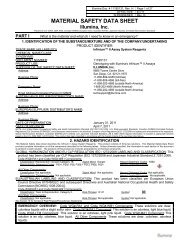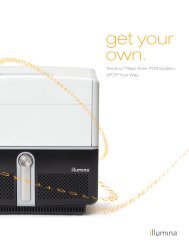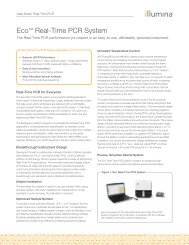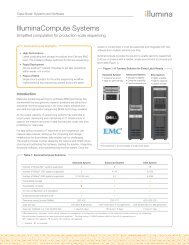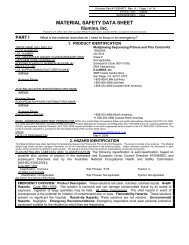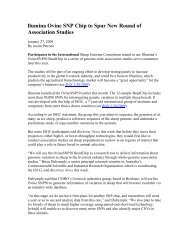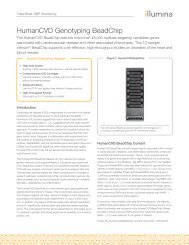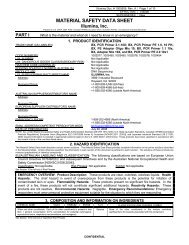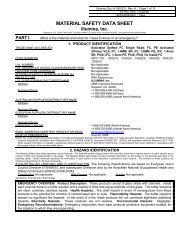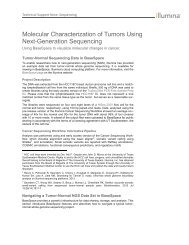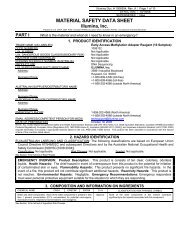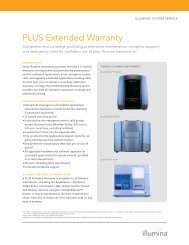MATERIAL SAFETY DATA SHEET - Illumina
MATERIAL SAFETY DATA SHEET - Illumina
MATERIAL SAFETY DATA SHEET - Illumina
Create successful ePaper yourself
Turn your PDF publications into a flip-book with our unique Google optimized e-Paper software.
TruSeq Enrichment Kit <strong>Illumina</strong> Doc. #15018476, Rev. A Page 15 of 17<br />
15. REGULATORY INFORMATION (Continued)<br />
ADDITIONAL AUSTRALIAN REGULATIONS (continued):<br />
ADDITIONAL LABELING:<br />
GA#-HP3: Corrosive. May produce severe burns. Attacks skin and eyes. Wear eye protection when mixing or using. Wear<br />
protective gloves when mixing or using. Do not mix with hot water. For advice, contact a Poisons Information Centre (Phone e.g.<br />
Australia 131 126; New Zealand 03 4747 000) or a doctor (at once). If swallowed, do NOT induce vomiting. If in eyes, hold<br />
eyelids apart and flush the eye continuously with running water. Continue flushing until advised to stop by the Poisons<br />
Information Centre or a doctor, or for at least 20 minutes. If skin or hair contact occurs, remove contaminated clothing and flush<br />
skin and hair with running water.<br />
ADDITIONAL JAPANESE REGULATIONS:<br />
JAPANESE ENCS: The constituents in this product’s solutions are on the ENCS Inventory as indicated in<br />
composition tables in Section 3 (Composition and Information on Ingredients).<br />
POISONOUS AND DELETERIOUS SUBSTANCES CONTROL LAW: The Alkali Hydroxide constituent in this<br />
product’s solutions is listed as a Deleterious Substance under the Poisonous and Deleterious Substances Control<br />
Law.<br />
PREPARED BY:<br />
REVISION INFORMATION:<br />
New.<br />
16. OTHER INFORMATION<br />
CHEMICAL <strong>SAFETY</strong> ASSOCIATES, Inc.<br />
PO Box 1961, Hilo, HI 96721 • 800/441-3365 • 808/969-4846<br />
DEFINITIONS OF TERMS<br />
A large number of abbreviations and acronyms appear on a MSDS. Some of these, which are commonly used, include the following:<br />
CAS #: This is the Chemical Abstract Service Number that uniquely identifies each EXPOSURE LIMITS IN AIR (continued):<br />
constituent.<br />
TWA: Time Weighted Average exposure concentration for a conventional 8-hr (TLV,<br />
EXPOSURE LIMITS IN AIR:<br />
PEL) or up to a 10-hr (REL) workday and a 40-hr workweek.<br />
CEILING LEVEL: The concentration that shall not be exceeded during any part of the HAZARDOUS <strong>MATERIAL</strong>S IDENTIFICATION SYSTEM HAZARD<br />
working exposure.<br />
RATINGS: This rating system was developed by the National Paint and Coating<br />
DFG MAKs: Federal Republic of Germany Maximum Concentration Values in the<br />
Association and has been adopted by industry to identify the degree of chemical hazards.<br />
workplace. Exposure limits are given as TWA (Time-Weighted Average) or PEAK (shortterm<br />
exposure) values.<br />
HEALTH HAZARD: 0 Minimal Hazard: No significant health risk, irritation of skin or<br />
eyes not anticipated. Skin Irritation: Essentially non-irritating. Mechanical irritation may<br />
DFG MAK Germ Cell Mutagen Categories: 1: Germ cell mutagens that have been<br />
occur. PII or Draize = 0. Eye Irritation: Essentially non-irritating, minimal effects<br />
shown to increase the mutant frequency in the progeny of exposed humans. 2: Germ<br />
clearing in < 24 hours. Mechanical irritation may occur. Draize = 0. Oral Toxicity LD50<br />
cell mutagens that have been shown to increase the mutant frequency in the progeny<br />
Rat: > 5000 mg/kg. Dermal Toxicity LD50 Rat or Rabbit: > 2000 mg/kg. Inhalation<br />
of exposed mammals. 3A: Substances that have been shown to induce genetic<br />
Toxicity 4-hrs LC50 Rat: > 20 mg/L. 1 Slight Hazard: Minor reversible injury may<br />
damage in germ cells of human of animals, or which produce mutagenic effects in<br />
occur; may irritate the stomach if swallowed; may defat the skin and exacerbate<br />
somatic cells of mammals in vivo and have been shown to reach the germ cells in an<br />
existing dermatitis. Skin Irritation: Slightly or mildly irritating. PII or Draize > 0 < 5. Eye<br />
active form. 3B: Substances that are suspected of being germ cell mutagens because<br />
Irritation: Slightly to mildly irritating, but reversible within 7 days. Draize > 0 ≤ 25. Oral<br />
of their genotoxic effects in mammalian somatic cell in vivo; in exceptional cases,<br />
Toxicity LD50 Rat: > 500–5000 mg/kg. Dermal Toxicity LD50 Rat or Rabbit: > 1000–<br />
substances for which there are no in vivo data, but that are clearly mutagenic in vitro<br />
2000 mg/kg. Inhalation Toxicity LC50 4-hrs Rat: > 2–20 mg/L. 2 Moderate Hazard:<br />
and structurally related to known in vivo mutagens. 4: Not applicable (Category 4<br />
Temporary or transitory injury may occur; prolonged exposure may affect the CNS.<br />
carcinogenic substances are those with non-genotoxic mechanisms of action. By<br />
Skin Irritation: Moderately irritating; primary irritant; sensitizer. PII or Draize ≥ 5, with<br />
definition, germ cell mutagens are genotoxic. Therefore, a Category 4 for germ cell<br />
no destruction of dermal tissue. Eye Irritation: Moderately to severely irritating;<br />
mutagens cannot apply. At some time in the future, it is conceivable that a Category 4<br />
reversible corneal opacity; corneal involvement or irritation clearing in 8–21 days.<br />
could be established for genotoxic substances with primary targets other than DNA<br />
Draize = 26–100, with reversible effects. Oral Toxicity LD50 Rat: > 50–500 mg/kg.<br />
[e.g. purely aneugenic substances] if research results make this seem sensible.) 5:<br />
Dermal Toxicity LD50 Rat or Rabbit: > 200–1000 mg/kg. Inhalation Toxicity LC50 4-hrs<br />
Germ cell mutagens, the potency of which is considered to be so low that, provided<br />
Rat: > 0.5–2 mg/L. 3 Serious Hazard: Major injury likely unless prompt action is taken<br />
the MAK value is observed, their contribution to genetic risk for humans is expected<br />
and medical treatment is given; high level of toxicity; corrosive. Skin Irritation:<br />
not to be significant.<br />
Severely irritating and/or corrosive; may cause destruction of dermal tissue, skin<br />
DFG MAK Pregnancy Risk Group Classification: Group A: A risk of damage to the<br />
burns, and dermal necrosis. PII or Draize > 5–8, with destruction of tissue. Eye<br />
developing embryo or fetus has been unequivocally demonstrated. Exposure of<br />
Irritation: Corrosive, irreversible destruction of ocular tissue; corneal involvement or<br />
pregnant women can lead to damage of the developing organism, even when MAK<br />
irritation persisting for more than 21 days. Draize > 80 with effects irreversible in 21<br />
and BAT (Biological Tolerance Value for Working Materials) values are observed.<br />
days. Oral Toxicity LD50 Rat: > 1–50 mg/kg. Dermal Toxicity LD50 Rat or Rabbit: > 20–<br />
Group B: Currently available information indicates a risk of damage to the developing<br />
200 mg/kg. Inhalation Toxicity LC50 4-hrs Rat: > 0.05–0.5 mg/L. 4 Severe Hazard:<br />
embryo or fetus must be considered to be probable. Damage to the developing<br />
Life-threatening; major or permanent damage may result from single or repeated<br />
organism cannot be excluded when pregnant women are exposed, even when MAK<br />
exposures; extremely toxic; irreversible injury may result from brief contact. Skin<br />
and BAT values are observed. Group C: There is no reason to fear a risk of damage<br />
Irritation: Not appropriate. Do not rate as a 4, based on skin irritation alone. Eye<br />
to the developing embryo or fetus when MAK and BAT values are observed. Group<br />
Irritation: Not appropriate. Do not rate as a 4, based on eye irritation alone. Oral<br />
D: Classification in one of the groups A–C is not yet possible because, although the<br />
Toxicity LD50 Rat: ≤ 1 mg/kg. Dermal Toxicity LD50 Rat or Rabbit: ≤ 20 mg/kg.<br />
data available may indicate a trend, they are not sufficient for final evaluation.<br />
Inhalation Toxicity LC50 4-hrs Rat: ≤ 0.05 mg/L.<br />
IDLH: Immediately Dangerous to Life and Health. This level represents a<br />
FLAMMABILITY HAZARD: 0 Minimal Hazard: Materials that will not burn in air when<br />
concentration from which one can escape within 30-minutes without suffering escapepreventing<br />
or permanent injury.<br />
exposure to a temperature of 815.5°C (1500°F) for a period of 5 minutes. 1 Slight<br />
Hazard: Materials that must be pre-heated before ignition can occur. Material requires<br />
LOQ: Limit of Quantitation.<br />
considerable pre-heating, under all ambient temperature conditions before ignition and<br />
NE: Not Established. When no exposure guidelines are established, an entry of NE is<br />
combustion can occur. This usually includes the following: Materials that will burn in<br />
made for reference.<br />
air when exposed to a temperature of 815.5°C (1500°F) for a period of 5 minutes or<br />
NIC: Notice of Intended Change.<br />
less; Liquids, solids and semisolids having a flash point at or above 93.3°C (200°F)<br />
NIOSH CEILING: The exposure that shall not be exceeded during any part of the<br />
(i.e. OSHA Class IIIB); and Most ordinary combustible materials (e.g. wood, paper,<br />
workday. If instantaneous monitoring is not feasible, the ceiling shall be assumed as a<br />
etc.). 2 Moderate Hazard: Materials that must be moderately heated or exposed to<br />
15-minute TWA exposure (unless otherwise specified) that shall not be exceeded at<br />
relatively high ambient temperatures before ignition can occur. Materials in this degree<br />
any time during a workday.<br />
would not, under normal conditions, form hazardous atmospheres in air, but under<br />
NIOSH RELs: NIOSH’s Recommended Exposure Limits.<br />
high ambient temperatures or moderate heating may release vapor in sufficient<br />
PEL: OSHA's Permissible Exposure Limits. This exposure value means exactly the<br />
quantities to produce hazardous atmospheres with air. This usually includes the<br />
same as a TLV, except that it is enforceable by OSHA. The OSHA Permissible<br />
following: Liquids having a flash-point at or above 37.8°C (100°F); Solid materials in<br />
Exposure Limits are based in the 1989 PELs and the June, 1993 Air Contaminants<br />
the form of course dusts that may burn rapidly but that generally do not form explosive<br />
Rule (Federal Register: 58: 35338-35351 and 58: 40191). Both the current PELs and<br />
atmospheres; Solid materials in a fibrous or shredded form that may burn rapidly and<br />
the vacated PELs are indicated. The phrase, “Vacated 1989 PEL” is placed next to the<br />
create flash fire hazards (e.g. cotton, sisal, hemp); and Solids and semisolids (e.g.<br />
PEL that was vacated by Court Order.<br />
viscous and slow flowing as asphalt) that readily give off flammable vapors. 3 Serious<br />
SKIN: Used when a there is a danger of cutaneous absorption.<br />
Hazard: Liquids and solids that can be ignited under almost all ambient temperature<br />
STEL: Short Term Exposure Limit, usually a 15-minute time-weighted average (TWA)<br />
conditions. Materials in this degree produce hazardous atmospheres with air under<br />
exposure that should not be exceeded at any time during a workday, even if the 8-hr<br />
almost all ambient temperatures, or, unaffected by ambient temperature, are readily<br />
TWA is within the TLV-TWA, PEL-TWA or REL-TWA.<br />
ignited under almost all conditions.<br />
TLV: Threshold Limit Value. An airborne concentration of a substance that represents<br />
conditions under which it is generally believed that nearly all workers may be<br />
repeatedly exposed without adverse effect. The duration must be considered,<br />
including the 8-hour.



